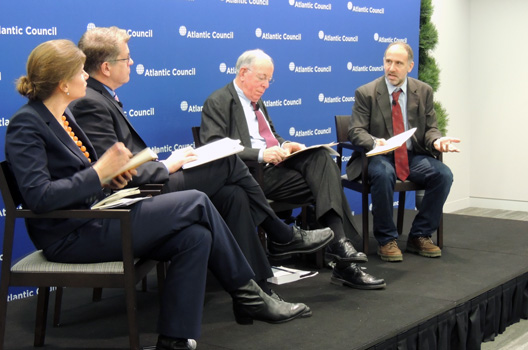 On Thursday February 27, 2014 the Strategic Foresight Initiative in the Brent Scowcroft Center for International Security held the captivating event “The Entrepreneurial State.” Experts weighed in on the role governments, research institutions, and the private sector in supporting innovation and research and development in the sciences. Discussants advocated for greater collaboration and cooperation as a means for building an environment supportive of innovation thus advancing and sustaining the United States’ innovation edge.
On Thursday February 27, 2014 the Strategic Foresight Initiative in the Brent Scowcroft Center for International Security held the captivating event “The Entrepreneurial State.” Experts weighed in on the role governments, research institutions, and the private sector in supporting innovation and research and development in the sciences. Discussants advocated for greater collaboration and cooperation as a means for building an environment supportive of innovation thus advancing and sustaining the United States’ innovation edge.
Dr. Mathew Burrows introduced Thomas Kalil, deputy director for technology and innovation in the White House’s Office of Science and Technology Policy who started off the discussion by posing many pertinent questions to the audience. How do we encourage the next generation of innovators and entrepreneurs and motivate young people to be involved in science, technology, engineering, and math? Are there systemic gaps in our nation’s innovation and research portfolio, and most importantly what are the moon shots of the 21st century? Mr. Kalil provided examples on how both the public and private sector have been catalysts for innovation. For example, the administration has a Sun Shot goal, to make solar power as cheap as coal by the end of the decade, and companies such as Qualcomm have developed a device called the tricorder which has the capability to diagnose a patient at the same capacity as a general physician. These are the important steps being made by both the public and private sector but more can be done.
Building upon Mr. Kalil’s questions, Dr. Mariana Mazzucato, R.M. Phillips professor in the economics of innovation at the University of Sussex and author of TheEntrepreneurial State, talked about the public sector’s role in research and innovation. Dr. Mazzucato advocated for the public sector elevating its role in the economy beyond being a steward or regulator that fixes market failure. Even though returns on investment are not guaranteed when supporting basic research, the risk is worth future gains for both the government and private sector. For example, smartphones and GPS exist because of government funding and research, not solely because of the ingenuity of Apple or other private companies.
The event continued with two panel discussions. The first panel discussion, moderated by Mr. Steve Clemons, editor-at-large for The Atlantic, focused on the historical role of the public and private sector in innovation. Panelist Dr. Dean Baker, co-director at the Center for Economic and Policy Research spoke of the state’s role in the economy, with particular focus on patents and how the cumbersome process to obtain them artificially raise the prices of goods thus hindering incentive to innovate through competition in the pharmaceutical industry, for example. Also on this panel was Ambassador Alan Wm. Wolff, cochair of the US National Academies’ Innovation Policy Forum, who discussed how, despite increased security incentive to protect scientific research, cross border information sharing is beneficial to fostering the creation of an intellectual environment adept at producing the next, big disruptive technologies.
The second panel was moderated by Mr. Edward Luce, Washington columnist and commentator for the Financial Times. On this panel Dr. Ruth A. David, president and CEO of Analytic Services, and Dr. William Bonvillian, director of the MIT Washington office, spoke about how the government needs to play a greater role in funding research for greater innovation. Sputnik and the Space Race were concrete examples of how the state was spurred by necessity to invest in innovation but the panel’s consensus was that government can’t keep waiting for a “Sputnik moment” to motivate investment in research. Instead, government should collaborate with private industry to help finance and motivate the brightest researchers and innovators to develop the next “great thing” that this country needs to stay ahead in the world. Private public partnerships are necessary to keep innovation alive and at a consistent level.
Ultimately, the potential for significant scientific and technological breakthroughs could be much greater if government, the private sector, and research institutions developed a coherent strategy to support each other.
